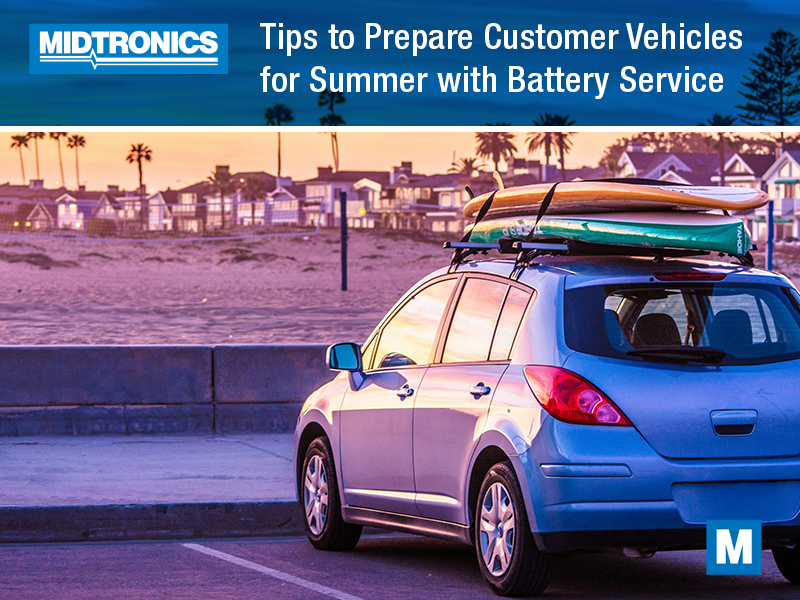Every year, spring weather gives way to summer heat and unpredictable weather conditions that accompany it. Getting out of winter unscathed is something to celebrate, but a vehicle is even more susceptible to the detriments that the summer can bring.
Whether you’re a shop owner, a technician, or a vehicle owner, preventative maintenance should be an emphasis to avoid frustrating problems – many of which are due to issues in the electrical system. Here are eight items to check and maintain in your multi-point inspection to prepare a vehicle for summer driving.
Test the Battery
Of the vehicles on the road today, one in five has a battery that needs to be replaced. The typical lifespan of a battery is between three and five years, and in southern areas, it’s even lower – around two years. Summer temperatures can accelerate electrolyte evaporation in a car battery.
The battery should be tested at the onset of summer to check that it still has the reserve capacity and cranking power to fire up the engine. If the battery is marginal or fails a test, a replacement should be installed to avoid getting stranded.
Clean the Battery Terminals and Cables
Fuzzy blue-green or white deposits on the battery terminals or cable ends are common, no matter what climate you drive in. The corrosion is due to the reaction between sulfuric acid escaping past the lead posts and the conditions in the atmosphere and metals. When the deposits form on battery posts and cables, it interrupts the flow of electrons, like pinching a garden hose. That can manifest as issues from starting problems to unusual electrical concerns.
The fix is fast and easy, and it needs to be done regularly – often twice a year. Neutralize and clean off the corrosion from the terminals, then ensure the cable ends are installed tightly.
Check the Alternator Function
It’s most common for an alternator to quit in extreme temperatures, whether that’s the throes of a frigid winter or the scorching temperatures of summer. It’s because the alternator is working harder than normal to provide power to systems like HVAC, heated and/or cooled seats, and the like. Over time, an alternator’s output can decrease from wear and tear, and it struggles to keep up in high-demand situations. A charging system test is always a good plan before these strenuous conditions are present.
Perform a Diagnostic Scan
You don’t need a Check Engine Light on in order for a vehicle to have concerning codes present. A diagnostic scan is a good idea during a multi-point inspection to ensure that there aren’t any problems on the horizon. These codes can vary from pending DTCs that are triggered for a momentary issue that goes away to stored codes that don’t necessarily trip the warning light right away; often, codes require multiple failed tests to illuminate a CEL.
Codes can range from transmission loss of prime or coolant temperature or misfire-related issues, not to mention a host of electrical codes for loss of communication and such. While they don’t necessarily need to be repaired immediately if codes are only pending, they can be an early sign that can be monitored.
Ensure the Cooling Fan Operates Properly
While you’re performing a diagnostic scan, check that the cooling fans are operating as they should. With many scan tools, you can monitor operating temperatures and the status of the cooling fan switching on and off. Some scan tools can even allow you to activate the fan at the press of a button. Ensure the fan sounds normal and comes on properly. The fan isn’t a common point of failure, but if it does, it can cause overheating in a very short time.
Verify Power Window and Door Lock Operation
Part of verifying that a vehicle is safe to operate, no matter what season you’re in, is ensuring that the power windows all open and the door locks all function. In the event of an emergency, fast egress is the most important factor for a good outcome. A slow or inoperable power window can indicate a weak motor or an electrical problem, and a door lock that doesn’t work or makes machine gun noises could trap someone inside or slow their ability to exit.
Inspect the Belts
Today, belts last years longer than they did in previous generations. They’re manufactured to a higher standard and are better reinforced, but they can and do still deteriorate with age and usage. A stretched and slipping belt can contribute to issues like decreased alternator output and power steering concerns. A broken belt when you’re driving can result in even more dire consequences.
Ensure the tension on the belts is correct, and replace belts if they’re cracked, glazed, or have pieces missing.
Check the Lights
Exterior lights are indicators meant to tell other motorists what the driver intends to do. They promote safety by allowing others on the road to know if the car is stopping or turning, as well as simply showing their position on the road. Dim or burnt-out bulbs are a safety concern that can result in near-misses or collisions, and all over bulbs that are a few dollars to change.
A multi-point inspection should cover inspecting the fluids, the cabin air filter and engine air filter, the tires, brakes, steering and suspension components, wiper blades, and much more. These eight items tend to be less common on the checklist, but they’re important for traveling safely in the summer. Many of these items, especially the battery, should be checked before summer and winter to help drivers avoid common problems related to extreme weather.




